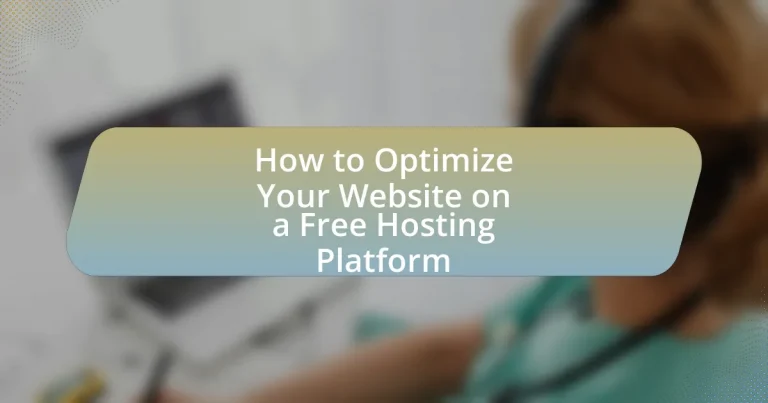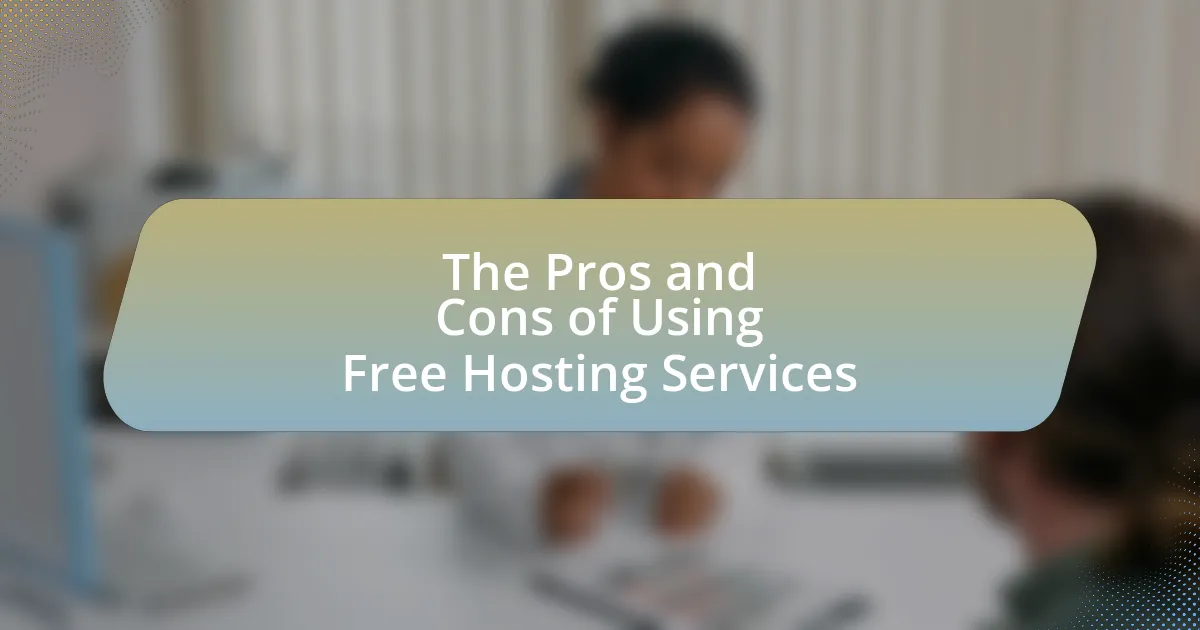Optimizing a website on a free hosting platform involves enhancing its performance, speed, and user experience while navigating the inherent limitations of such services. Key strategies include minimizing file sizes, improving loading speeds, and implementing effective SEO practices to counteract the negative impacts of restricted bandwidth and storage. The article explores the challenges posed by free hosting, such as slower loading times and limited support, while providing actionable techniques for optimization, including image compression, mobile responsiveness, and keyword integration. Additionally, it highlights the importance of regular maintenance and analytics in driving continuous improvement and user engagement.

What does it mean to optimize your website on a free hosting platform?
Optimizing your website on a free hosting platform means enhancing its performance, speed, and user experience while working within the limitations of the free service. This involves techniques such as minimizing file sizes, using efficient coding practices, and leveraging caching to improve load times. For instance, studies show that a one-second delay in page load time can lead to a 7% reduction in conversions, highlighting the importance of speed optimization. Additionally, optimizing images and utilizing content delivery networks (CDNs) can further enhance accessibility and performance, even on free hosting platforms that may have bandwidth restrictions.
How does free hosting impact website performance?
Free hosting negatively impacts website performance by limiting resources such as bandwidth, storage, and server speed. These constraints often lead to slower loading times, increased downtime, and reduced reliability, which can deter visitors and harm search engine rankings. For instance, a study by Google found that 53% of mobile users abandon sites that take longer than three seconds to load, highlighting the critical nature of performance. Additionally, free hosting services may impose restrictions on the number of concurrent users, further exacerbating performance issues during peak traffic times.
What are the limitations of free hosting services?
Free hosting services have several limitations, including restricted storage space, limited bandwidth, and lack of customer support. These services often impose caps on the amount of data that can be stored and transferred, which can hinder website performance and accessibility. Additionally, free hosting typically includes advertisements, which can detract from the user experience and brand image. Security features are often minimal, leaving websites vulnerable to attacks. Furthermore, users may not have access to custom domain names, which can affect credibility and search engine optimization. These limitations can significantly impact the functionality and professionalism of a website hosted on a free platform.
How can these limitations affect website optimization?
Limitations of free hosting platforms can significantly hinder website optimization by restricting resources such as bandwidth, storage, and server performance. These constraints can lead to slower loading times, which negatively impact user experience and search engine rankings, as studies show that a one-second delay in page load time can reduce conversions by 7%. Additionally, limited customization options may prevent the implementation of essential SEO practices, such as meta tags and structured data, further diminishing visibility in search results. Consequently, these factors collectively undermine the effectiveness of optimization efforts, making it challenging to achieve desired performance and reach target audiences effectively.
Why is website optimization important for free hosting users?
Website optimization is crucial for free hosting users because it enhances website performance and user experience despite the limitations of free hosting services. Free hosting often comes with slower loading times, limited bandwidth, and less reliable uptime, making optimization essential to mitigate these drawbacks. For instance, studies show that a one-second delay in page load time can lead to a 7% reduction in conversions, emphasizing the need for speed and efficiency. By optimizing images, minimizing code, and leveraging caching, free hosting users can significantly improve their site’s responsiveness and overall functionality, ensuring that visitors have a positive experience and are more likely to return.
What benefits does optimization provide for user experience?
Optimization enhances user experience by improving website speed, accessibility, and usability. Faster loading times lead to lower bounce rates; for instance, a study by Google found that a one-second delay in loading time can decrease conversions by 20%. Additionally, optimization ensures that websites are mobile-friendly, which is crucial as over 50% of global web traffic comes from mobile devices. Improved usability through intuitive navigation and clear layouts further increases user satisfaction, as evidenced by research from the Nielsen Norman Group, which indicates that users are more likely to engage with well-structured sites. Overall, optimization directly correlates with increased user engagement and satisfaction.
How does optimization influence search engine rankings?
Optimization directly influences search engine rankings by enhancing a website’s relevance and usability, which search engines prioritize in their algorithms. Effective optimization techniques, such as keyword integration, meta tag usage, and improving site speed, lead to better user experience and increased engagement metrics. For instance, according to a study by Backlinko, the first page of Google search results receives 71% of all clicks, highlighting the importance of ranking high through optimization. Additionally, Google’s algorithm updates, such as the Core Web Vitals, emphasize the significance of site performance and user experience, further validating that well-optimized websites are more likely to achieve higher rankings.

What strategies can be employed to optimize a website on a free hosting platform?
To optimize a website on a free hosting platform, focus on improving loading speed, enhancing SEO, and utilizing responsive design. Improving loading speed can be achieved by compressing images and minimizing code, which directly impacts user experience and search engine rankings. Enhancing SEO involves using relevant keywords in titles, meta descriptions, and content, which helps increase visibility in search engine results. Utilizing responsive design ensures that the website is accessible and user-friendly across various devices, which is crucial as mobile traffic continues to rise. These strategies collectively contribute to better performance and user engagement on free hosting platforms.
How can you improve website loading speed on free hosting?
To improve website loading speed on free hosting, optimize images and minimize file sizes. Large images can significantly slow down loading times; using tools like TinyPNG or ImageOptim can reduce their size without sacrificing quality. Additionally, leverage browser caching by setting appropriate cache headers, which allows returning visitors to load your site faster. Implementing a Content Delivery Network (CDN) can also enhance speed by distributing content across multiple servers globally, reducing latency. Furthermore, minimize HTTP requests by combining CSS and JavaScript files, which decreases the number of requests made to the server. These strategies collectively enhance loading speed, even on free hosting platforms.
What tools can help analyze website speed?
Tools that can help analyze website speed include Google PageSpeed Insights, GTmetrix, and Pingdom. Google PageSpeed Insights evaluates the performance of a webpage on both mobile and desktop devices, providing suggestions for improvement based on real-world data. GTmetrix combines Google Lighthouse and WebPageTest to offer detailed insights into page load times and performance scores, along with recommendations for optimization. Pingdom allows users to test website speed from multiple locations globally, providing a comprehensive overview of load times and performance metrics. These tools are widely recognized in the industry for their accuracy and effectiveness in identifying speed-related issues on websites.
How can image optimization enhance loading times?
Image optimization enhances loading times by reducing the file size of images without significantly compromising quality. Smaller image files require less bandwidth and load faster, which is crucial for user experience and search engine rankings. For instance, studies show that optimized images can reduce page load times by up to 80%, leading to lower bounce rates and higher engagement. Additionally, tools like JPEGmini and TinyPNG can compress images effectively, demonstrating that proper optimization techniques directly correlate with improved loading speeds.
What role does mobile responsiveness play in optimization?
Mobile responsiveness is crucial for optimization as it ensures that websites function effectively across various devices, particularly smartphones and tablets. This adaptability enhances user experience, leading to lower bounce rates and increased engagement. According to Google, mobile-friendly websites rank higher in search results, as the search engine prioritizes mobile usability in its algorithms. Furthermore, Statista reports that over 50% of global web traffic comes from mobile devices, underscoring the necessity for websites to be optimized for mobile viewing to capture and retain a significant audience.
How can you ensure your website is mobile-friendly?
To ensure your website is mobile-friendly, implement a responsive design that adapts to various screen sizes. Responsive design uses flexible grids and layouts, allowing content to adjust seamlessly across devices. According to Google, 61% of users are unlikely to return to a mobile site they had trouble accessing, highlighting the importance of mobile optimization. Additionally, using tools like Google’s Mobile-Friendly Test can help identify issues and ensure compliance with mobile usability standards.
What testing tools can verify mobile responsiveness?
Testing tools that can verify mobile responsiveness include Google Mobile-Friendly Test, BrowserStack, and Responsinator. Google Mobile-Friendly Test evaluates a webpage’s mobile usability and provides suggestions for improvement, while BrowserStack allows users to test websites across various devices and browsers in real-time. Responsinator offers a quick way to see how a site appears on different screen sizes. These tools are widely recognized in the industry for their effectiveness in assessing mobile responsiveness.

What are the best practices for optimizing content on a free hosting platform?
The best practices for optimizing content on a free hosting platform include focusing on SEO, ensuring mobile responsiveness, and utilizing lightweight media. SEO optimization involves using relevant keywords in titles, headings, and throughout the content to improve search engine visibility. Mobile responsiveness is crucial as over 50% of web traffic comes from mobile devices; thus, content should be easily accessible and readable on smaller screens. Additionally, using lightweight media, such as compressed images and optimized videos, enhances loading speed, which is essential since slow-loading pages can lead to higher bounce rates. These practices collectively improve user experience and search engine rankings, making the content more effective on free hosting platforms.
How can you effectively use keywords for SEO?
To effectively use keywords for SEO, identify relevant keywords that align with your content and audience intent. Conduct keyword research using tools like Google Keyword Planner or SEMrush to find high-volume, low-competition keywords. Incorporate these keywords naturally into your website’s title tags, meta descriptions, headers, and throughout the content to enhance visibility. According to a study by Ahrefs, pages that rank in the top 10 search results contain the target keyword in the title tag 75% of the time, demonstrating the importance of strategic keyword placement.
What tools can assist in keyword research?
Keyword research can be effectively assisted by tools such as Google Keyword Planner, SEMrush, Ahrefs, and Ubersuggest. Google Keyword Planner provides insights into search volume and competition for keywords, making it essential for identifying relevant terms. SEMrush offers comprehensive keyword analysis, including keyword difficulty and related keywords, which aids in strategic planning. Ahrefs is known for its extensive database and backlink analysis, helping users discover keywords that drive traffic. Ubersuggest provides keyword suggestions and SEO metrics, making it user-friendly for beginners. These tools are widely recognized in the digital marketing community for their accuracy and effectiveness in keyword research.
How should keywords be integrated into website content?
Keywords should be integrated into website content by strategically placing them in key areas such as titles, headings, meta descriptions, and throughout the body text. This approach enhances search engine visibility and improves user engagement. Research indicates that using keywords in these specific locations can increase click-through rates by up to 36% (Source: HubSpot, “The Ultimate Guide to SEO”). Additionally, maintaining a natural flow in the content while avoiding keyword stuffing is crucial, as search engines prioritize user experience and readability.
What techniques can enhance user engagement on your website?
To enhance user engagement on your website, implement interactive elements such as quizzes, polls, and comment sections. These features encourage user participation and create a sense of community, leading to increased time spent on the site. Research shows that websites with interactive content can achieve up to 70% higher engagement rates compared to static content. Additionally, optimizing website speed and ensuring mobile responsiveness are crucial, as studies indicate that 53% of mobile users abandon sites that take longer than three seconds to load. By focusing on these techniques, you can significantly improve user engagement on your website.
How can you utilize multimedia to improve engagement?
Utilizing multimedia, such as videos, images, and interactive content, significantly enhances user engagement on websites. Research indicates that incorporating videos can increase user retention by up to 95%, as they provide a dynamic way to convey information. Additionally, using high-quality images can improve the aesthetic appeal of a website, leading to longer visit durations. Interactive elements, like quizzes or polls, encourage user participation, fostering a sense of community and increasing the likelihood of return visits. These multimedia elements not only capture attention but also facilitate better understanding and retention of content, ultimately driving higher engagement rates.
What are the best practices for creating compelling calls to action?
The best practices for creating compelling calls to action include using clear and concise language, creating a sense of urgency, and ensuring visibility on the webpage. Clear language helps users understand what action to take, while urgency encourages immediate responses, such as using phrases like “limited time offer.” Visibility is crucial; placing the call to action in prominent locations, such as above the fold or at the end of engaging content, increases the likelihood of user interaction. Research shows that buttons with contrasting colors can improve click-through rates by up to 21%.
What common pitfalls should be avoided when optimizing a website on free hosting?
Common pitfalls to avoid when optimizing a website on free hosting include neglecting performance limitations, overlooking SEO constraints, and failing to secure the site. Free hosting often comes with bandwidth and storage restrictions, which can lead to slow loading times and downtime, negatively impacting user experience and search rankings. Additionally, many free hosting services do not allow for custom domain names or advanced SEO features, limiting visibility in search engines. Security is also a concern, as free hosting may lack robust security measures, making sites vulnerable to attacks. These factors collectively hinder the effectiveness of website optimization efforts.
How can overloading your website with plugins harm performance?
Overloading a website with plugins can significantly harm performance by increasing load times and consuming server resources. Each plugin adds additional code that must be executed, which can slow down page rendering and lead to longer wait times for users. Research indicates that websites with excessive plugins can experience a decrease in speed by up to 50%, negatively impacting user experience and search engine rankings. Furthermore, plugins can introduce security vulnerabilities and conflicts with other plugins, further degrading performance and stability.
What are the risks of neglecting regular updates and maintenance?
Neglecting regular updates and maintenance poses significant risks, including security vulnerabilities, performance degradation, and compatibility issues. Security vulnerabilities arise because outdated software can be exploited by cybercriminals, leading to data breaches; for instance, according to a report by Verizon, 43% of data breaches involve small businesses, often due to unpatched software. Performance degradation occurs as outdated systems may slow down, resulting in a poor user experience; studies show that a one-second delay in page load time can lead to a 7% reduction in conversions. Compatibility issues can arise when new technologies or plugins are introduced, potentially breaking existing functionalities on the website. Therefore, regular updates and maintenance are crucial to mitigate these risks and ensure optimal website performance.
What practical tips can help you optimize your website effectively?
To optimize your website effectively, focus on improving loading speed, enhancing mobile responsiveness, and utilizing SEO best practices. Improving loading speed can be achieved by compressing images, minimizing CSS and JavaScript files, and leveraging browser caching, which can reduce load times by up to 50% according to Google’s PageSpeed Insights. Enhancing mobile responsiveness ensures that your website adapts to various screen sizes, which is crucial as over 50% of web traffic comes from mobile devices, according to Statista. Utilizing SEO best practices, such as optimizing meta tags, using relevant keywords, and creating quality content, can increase your visibility on search engines, with studies showing that 75% of users never scroll past the first page of search results.
How can you leverage analytics to inform optimization efforts?
You can leverage analytics to inform optimization efforts by analyzing user behavior data to identify areas for improvement on your website. For instance, tools like Google Analytics provide insights into page views, bounce rates, and user demographics, allowing you to pinpoint which pages are underperforming. By examining this data, you can make informed decisions, such as optimizing content for higher engagement or improving navigation to reduce bounce rates. Studies show that businesses using data-driven decision-making are 5-6% more productive and profitable than their competitors, highlighting the effectiveness of analytics in driving optimization strategies.
What are some quick wins for immediate website improvements?
To achieve immediate website improvements, focus on optimizing page load speed, enhancing mobile responsiveness, and improving content readability. Optimizing page load speed can be accomplished by compressing images and leveraging browser caching, which can reduce load times by up to 50%, as reported by Google. Enhancing mobile responsiveness ensures that your website adapts seamlessly to various screen sizes, which is crucial since over 50% of web traffic comes from mobile devices, according to Statista. Improving content readability involves using clear headings, bullet points, and concise paragraphs, which can increase user engagement and reduce bounce rates, as studies show that well-structured content retains visitors longer.





